
The Bottom Line
Introduction, Specifications, and Pricing
Team Group's Cardea Liquid seems to be getting all of the headlines these days, but the Cardea II uses the same controller, flash, and comes with an extravagant cooler, too.
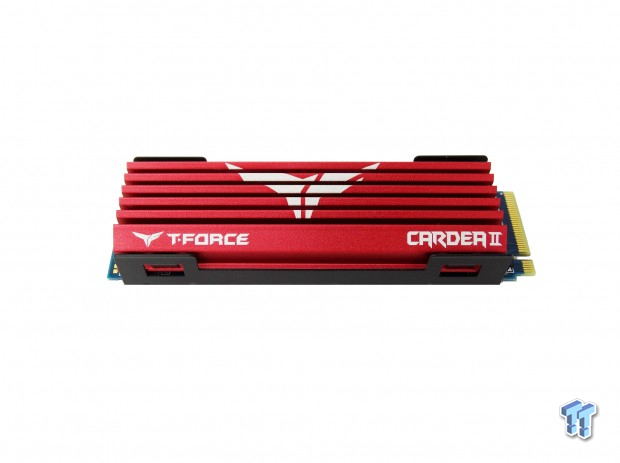
The Cardea II an updated version of the original Cardea that came to market in 2017 with the Phison PS5012-E7 controller and MLC flash. The updated model follows the Phison release schedule with the PS5012-E12 controller paired with Toshiba 64L flash memory.
The updated model is quite a bit quicker than the previous version, and both include the same extruded aluminum passive cooler with T-Force (Team Group's gaming brand) graphics. The Phison E7 controller ran much hotter than the newer E12 with the later using a much more modern process node. Under heavy reads and writes the E12 can still throttle, decreasing performance, but the new process node increases the time it takes for the controller to reach throttle temperatures. The Cardea II's heat sink works to extend the time it takes the drive to throttle to the point where nearly all consumer workloads are immune to the condition.
Specifications
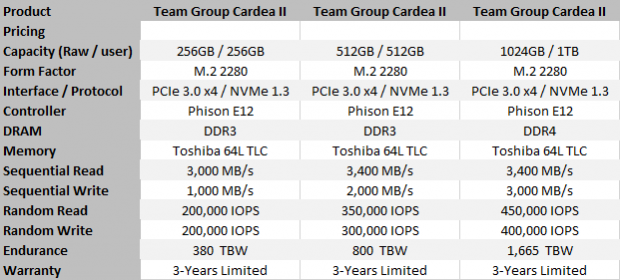
Team Group will release the Cardea II in three capacities ranging from 256GB to 1TB. The largest size uses a DDR4 DRAM buffer, and the 256GB and 512GB use a DDR3 buffer, but the E12 controller and 64L Toshiba BiCS FLASH remain the same.
The performance changes with each capacity with the 1TB model sporting the highest results, 3,400 MB/s sequential read, and 3,000 MB/s sequential write speeds. It also offers 450,000 IOPS read and 400,000 IOPS write.
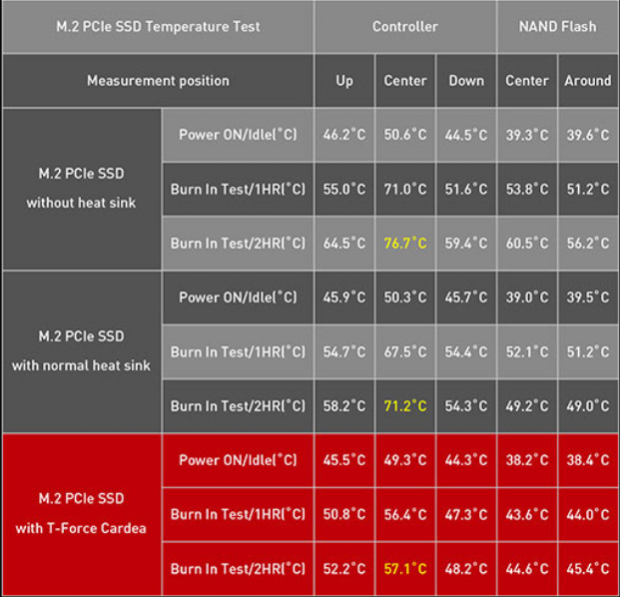
The company published a graph showing temperatures with and without a heat sink. We assume the model without a heat sink is the MP34, also from the company. The "normal" heat sink is likely similar to the thin metal shield ADATA ships on the GAMMIX product line. Finally, the graph shows the Cardea II with the over-the-top extruded aluminum heat sink that is in a class above what most companies use on premium SSDs today.
Pricing, Warranty, and Endurance
We were not able to find the Cardea II series available at the time of writing. Team Group has a number of series with the E12 controller, and this model fits right in the middle. The Team Group T-Force MP34 that we recently tested is the base series with prices starting at $39.99 for the 256GB drive and $159.99 for the 1TB model. We expect the Cardea II to cost slightly more, but not as much as the premium Cardea Liquid. The Liquid model is also not available yet at Amazon or Newegg in North America.
A Closer Look
A Closer Look
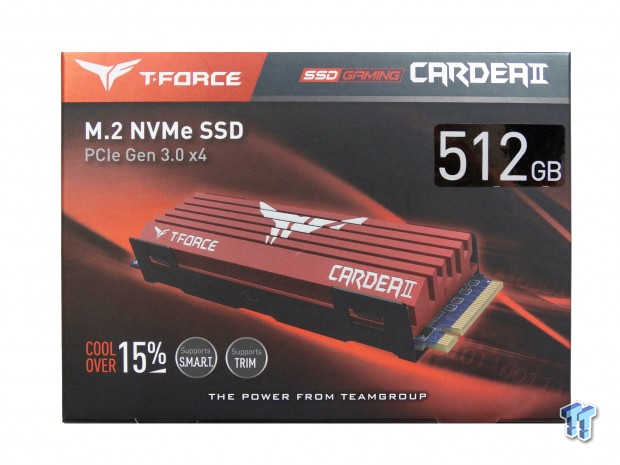


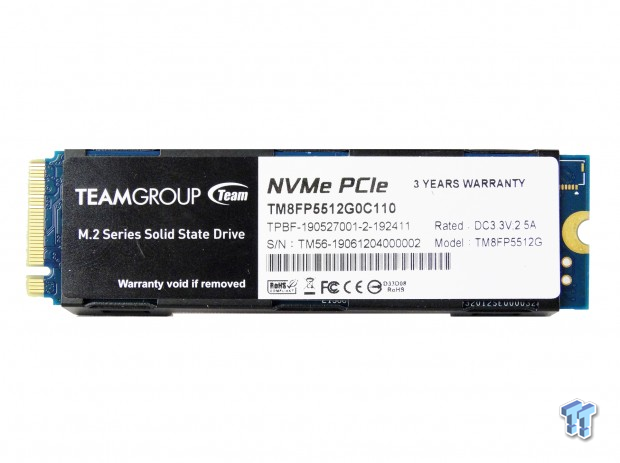
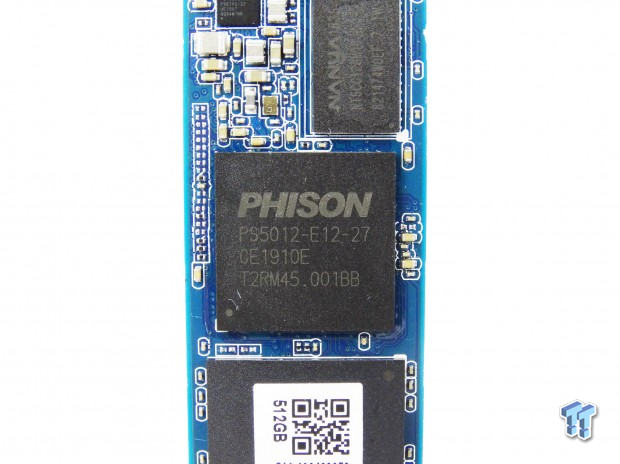
Team Group has stepped up the product packaging for the T-Force Series, the company's gaming product line.
The Cardea II looks nearly identical to the first Cardea and even uses the same heat sink design with a minor graphics update. The real difference is under the heat sink where the Cardea II sports a Phison PS5012-E12. The first generation Cardea used the older Phison PS5007-E7.
Sequential Performance
Sequential Read Performance
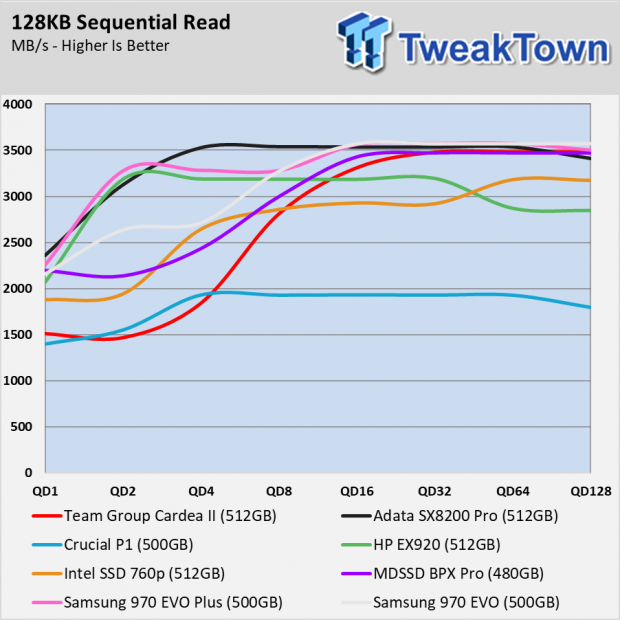

SSDs based on the Phison E12 controller don't play well with our sequential read test. These drives show low performance in queue depth (QD) 2 and 4. We've had the same issue with some of Intel's early NVMe SSDs.
The Cardea II shows the same low performance at QD2 and QD4, but this isn't an issue with the drive per se. In other software, the numbers are much higher. The Cardea II does reach peak performance of 3,500 MB/s at higher queue depths.
Sequential Write Performance


Our 512GB Cardea II surpasses 2,000 MB/s in our sequential write test. The drive only dips below that number at QD1, but there is very little roll-off at low queue depths.
Sustained Sequential Write Performance

The sustained sequential write performance leads all of the other drives in the chart today. This is in part due to the extruded aluminum cooler. The newer firmware also helps the drive sustain very high throughput as we write to the entire drive with 128KB sequential data.
Random Performance
Random Read Performance


The Phison E12 paired with Toshiba BiCS FLASH memory was never able to reach the stratosphere random read numbers at low queue depths like the models with Micron's 64L/96L 3-bit per cell memory. The Cardea II does deliver strong performance down low that is comparable to Samsung's 970 EVO Plus. On the other end of the scale, at high queue depths, this drive reaches peak IOPS higher than any other 512GB-class SSD in the charts today.
Random Write Performance


Phison and its partners have really tuned up the E12 firmware. In the random write test, the Cardea II again shows us higher peak performance than any other drive on the chart. At lower queue depth, the drive trails the others. This doesn't concern us too much because all modern SSDs with an SLC buffer absorb random writes much faster than older SSDs. In consumer workloads, the random writes are usually very brief, and the SLC buffer catches the data without any perceived performance loss.
Mixed Workload Performance
70% Read Sequential Performance

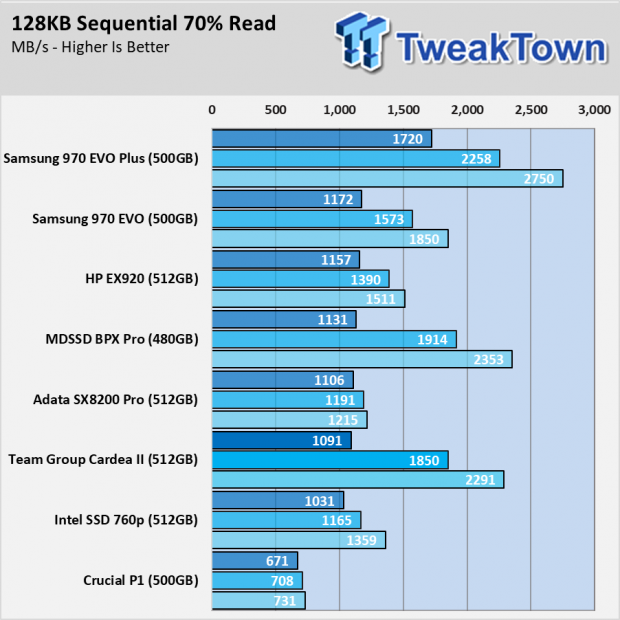
As a boot drive, your PC sends hundreds of small reads and writes to the storage at any given moment. The way your drive handles these mixed workloads can make a big difference in how fast your system feels.
The 512GB Cardea II tackles large block size sequential writes ease. Many of the other drives struggle in this capacity because they use fewer flash die than the larger capacity models.
70% Read Random Performance
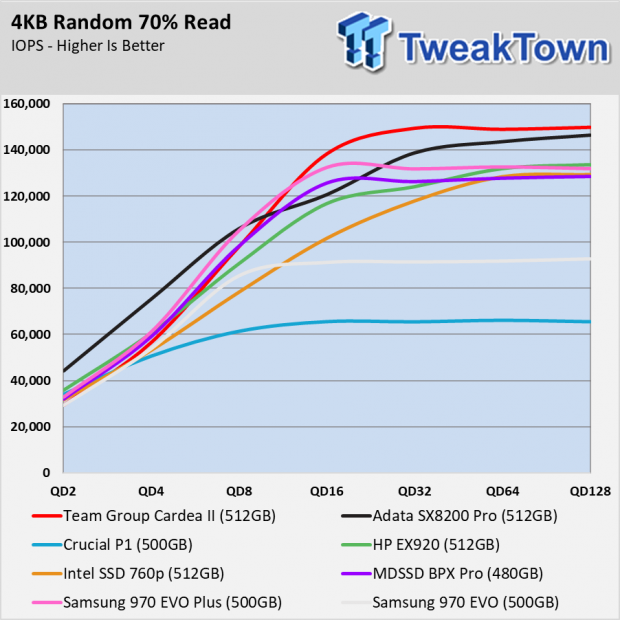
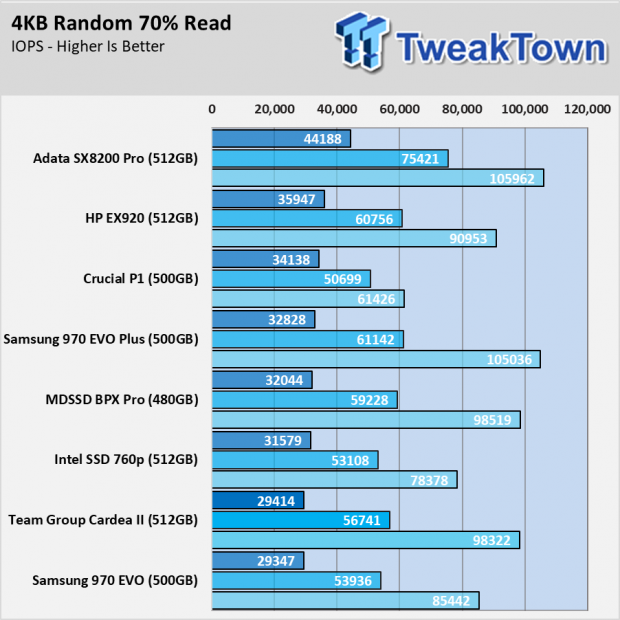
The drive also performs really well with random mixed workloads. These are closer to the files that your operating system and applications read and write in the background.
Application Performance
Game Load Time

The first thing you will notice in the game load-time test from Final Fantasy: Stormbood is just how close most of the drives load the levels. The Cardea II is right around 1 second off the best time on the chart, but that is still a very close set of results compared to hard disk drives.
PCMark 8 Storage Bandwidth

The PCMark 8 Storage Test uses a wider range of applications to measure disk performance. The tests range from two games to Microsoft and Adobe applications. The Cardea II performs really well in this broad-spectrum suite and even outperforms the Samsung 970 EVO Plus in this capacity.
PCMark 8 Extended Storage Test
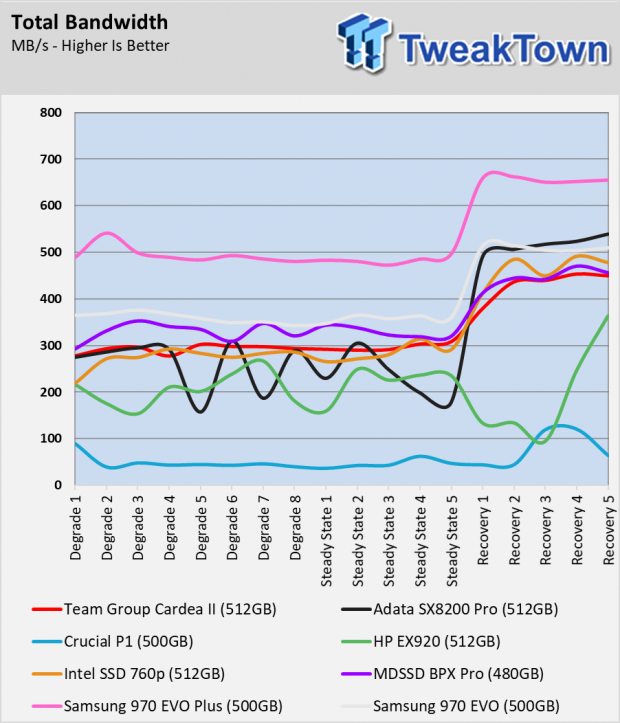
The PCMark 8 Extended Storage Test uses the same applications but starts with the drive in a degraded performance state from long data writes to the drives. The software then runs the applications over and over for several passes without a break that allows the drive to perform garbage collection effectively. In the recovery stages, the portion of the test we focus on, the drives get five minutes of recovery time to show how quickly performance recovers.
Under heavy workloads, many of the drives cluster together with varying degrees of consistency. The 512GB Cardea II shows very consistent performance through the degraded and steady-state phases. In the recovery phases, the drive takes a little longer but manages to get back up to pace before the test ends.
Application Latency and Notebook Battery Life
SYSmark 2014 SE System Responsiveness Test

We use a Lenovo Ideapad Y700-17 gaming notebook for both tests on this page. The first is the BAPCo SYSmark 2014 SE Responsiveness Test. This test measures systems response, what makes your PC feel fast.
The 512GB Team Group T-Force Cardea II surpasses the 1,000-point mark set by an OEM version of the Samsung 850 EVO. We consider the reference line to be very responsive, and any drive that scores higher is an excellent boot drive for your PC.
MobileMark 2012 Version 1.5
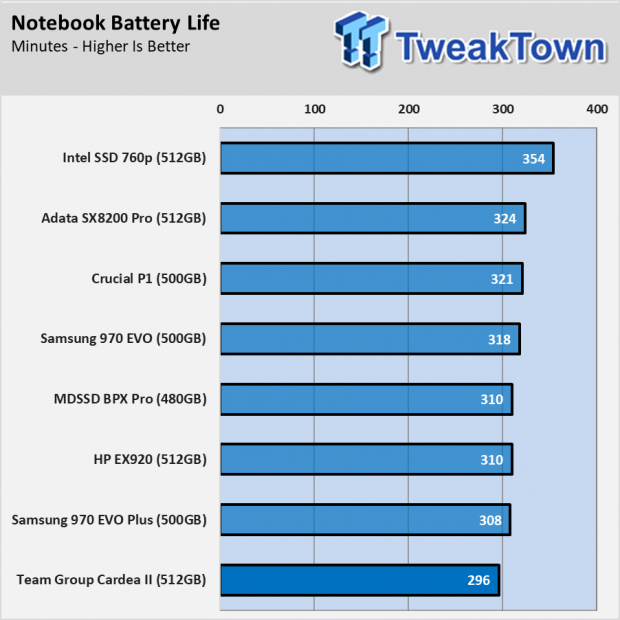
We managed to cram the large heat sink Cardea II in our Lenovo notebook, but I wouldn't expect this drive to fit in many mobile systems. The drive wasn't designed for notebook use, but since it fits we tested it for battery life. The drive didn't reach five hours but managed to get very close in this power-hungry system.
Final Thoughts
It's difficult to determine the overall value of the 512GB Team Group T-Force Cardea II we tested today without retail pricing. The previous Cardea didn't carry a large premium over the model sold without the heat sink. For the first time, Team Group has three tiers with an NVMe SSD with the MP34 (base model), Cardea II, and the recently announced Cardea Liquid (flagship model). With low SSD prices and shoppers unwillingness to splurge on storage, we see the MP34 and Cardea II very close in price.

For most users, the heat sink will offer little value under daily usage. Gamers will not see a noticeable improvement in load times, but can expect reduced game installation times when the drive reads and writes downloaded files while compiling the folder directory (installing the game). For most gamers, this is the most intensive task performed on the PC, and saving a few seconds to a few minutes for triple-A titles is a nice benefit.
The original Cardea was one of my favorite drives that came to market in 2017. The Phison E12 doesn't generate as much heat as the E7, but it never hurts to cool your SSD if the additional cost is reasonable. Drive that sit under video cards that reduce airflow to the SSD benefit the most from having a heat sink. That encompasses most gamers these days. Casual gamers can save a few dollars, but if you want to shave some time from your long installation times, spend a few dollars more for the Cardea II.
Performance |
94% |
Quality |
96% |
Features |
95% |
Value |
91% |
Overall |
94% |
The Team Group T-Force Cardea II is a great SSD for gamers and power users. The heat sink is a little over the top, but that's the way we like it.

Similar Content
Related Tags
